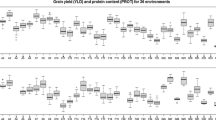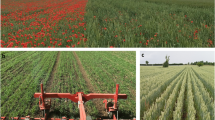Abstract
The move toward resilient and productive agriculture requires, among other innovations, the design of new sustainable farming systems in which the variety plays a main role. Plant breeding strategies adapted to organic farming conditions have to deal with limiting factors. Whereas in north-west France, it is known that trials carried out under high-input management do not give a good prediction of genotype performance in organic conditions, less is known about the relative stability of wheat genotypes between low-input (LI) and organic cropping systems. A retrospective analysis of 34 winter wheat trials conducted from 2004 to 2011 was performed to determine whether data obtained on genotypes grown under LI conditions can be used to predict genotype performance in organic (ORG) target conditions. Every year, ORG and LI (no fungicide or growth regulators, N balance sheet-60 kgN/ha, weed control with herbicides) trials including 25–30 genotypes describing a large range of genetic diversity were sown in three different agro-climatic regions across north-west France. Genotype performance in ORG management system was reduced from 25 to 40 % for yield and from 10 to 22 % for grain protein content. Estimates of genotypic values appeared to be more precise under LI than ORG conditions. Because of high genetic correlations between LI and ORG conditions, the relative efficiency of indirect selection from LI to ORG conditions was approximately 1. Spearman’s rank correlations were high (Rs = 0.54–0.92) and genotype rank inversions generally had a minor extent. However, in 2005 and 2010, almost 50 % of the lines had to be retained in LI to keep 80 % of the top 20 % of genotypes in organic conditions. Compared with previous results from high-input conditions, LI management provided a better prediction of genotype performance under ORG conditions but crossover genotype × management interactions could be observed between both systems. Overall, combining information provided from both LI and ORG crop management systems appears to be a good process for building efficient and adapted breeding schemes for ORG farming conditions.



Similar content being viewed by others
Abbreviations
- INRA:
-
French National Institute for Agricultural Research
- ORG:
-
Organic farming
- LI:
-
Low-input
- H:
-
Broad-sense heritability
- RSE:
-
Residual standard error
- BIPEA:
-
French bread-making quality test (NFV03-716)
- VCU:
-
Value for cultivation and use
References
Annicchiaricho P, Chiapparino E, Perenzin M (2010) Response of common wheat varieties to organic and conventional production systems across Italian locations, and implications for selection. Field Crops Res 116:230–238
Baenziger P, Salah SI, Little RS, Santra DK, Regassa T, Wang MY (2011) Structuring an efficient organic wheat breeding program. Sustainability 3:1190–1205
Baresel JP, Reents HJ (2006) Observations on long-term wheat variety trials under organic and conventional conditions in Germany. In: Østergård H, Fontaine L (eds) Proceedings of the COST SUSVAR workshop on cereal crop diversity: Implications for production and products. ITAB Press, Paris, pp 83–87
Bouchard C, Bernicot MH, Félix I, Guérin O, Omon B, Loyce C, Rolland B (2008) Associer des itinéraires techniques de niveau d’intrants variés à des variétés rustiques de blé tendre : évaluation économique, environnementale et énergétique. Le Courrier de l’Environnement de l’INRA 55:49–77
Brancourt-Hulmel M, Heumez E, Pluchard P, Beghin D, Depatureaux C, Giraud A, Le Gouis J (2005) Indirect versus direct selection of winter wheat for low-input or high-input levels. Crop Sci 45:14–27
Burdon RD (1977) Genetic correlation as a concept for studying genotype-environment interaction in forest tree breeding. Silvae Genet 26:168–175
Burger H, Schloen M, Schmidt W, Geiger HH (2008) Quantitative genetic studies on breeding maize for adaptation to organic farming. Euphytica 163:501–510
Ceccarelli S (1994) Specific adaptation and breeding for marginal conditions. Euphytica 77:205–219
Ceccarelli S (1996) Adaptation to low/high input cultivation. Euphytica 92:203–214
Drews S, Neuhoff D, Kopke U (2009) Weed suppression ability of three winter wheat varieties at different row spacing under organic farming conditions. Weed Res 49:526–533
Falconer DS, Mackay TFC (1996) Introduction to quantitative genetics. Pearson Education Limited, Essex
FranceAgriMer (2013) Variétés et rendement des céréales biologiques—Récolte 2012. Données et bilans, 7p. www.franceagrimer.fr/content/download/24612/204265/file/ENQ-GRC-VariétésRendBio-A2012.pdf
Gallais A (1989) Théorie de la sélection en amélioration des plantes. Masson, Paris, p 588
Gevrek MN, Atasoy GD (2012) Performance of some bread wheat genotypes under organic and conventional production systems. Int J Agric Biol 14:580–584
Kamran A, Kubota H, Yang RC, Randhawa HS, Spaner D (2013) Relative performance of Canadian spring wheat cultivars under organic and conventional field conditions. Euphytica. doi:10.1007/s10681-013-1010-3
Kirk AP, Fox SL, Entz MH (2012) Comparison of organic and conventional selection environments for spring wheat. Plant Breed 131:687–694
Kleijer G, Schwärzel R (2006) Qualité boulangère du blé d’automne dans les essais d’homologation extenso et bio. Revue Suisse d’Agriculture 38:31–34
Kunz P, Becker K, Buchmann M, Cuendet C, Müller J, Müller U (2006) Die züchtung von top-qualitätsweizen für den biologischen landbau. Bericht 56. Tagung 2005 der Vereinigung der Pflanzenzüchter und Saatgutkaufleute Osterreichs, Nov 22–24. HBLFA für Landwirtschaft Raumberg-Gumpenstein, Irdning, Austria, pp 3–7
Lafitte HR, Edmeades GO (1994) Improvement for tolerance to low soil nitrogen in tropical maize: selection criteria. Field Crops Res 39:1–14
Lammerts van Bueren ET, Jones SS, Tamm L, Murphy K, Myers JR, Leifert C, Messmer MM (2011) The need to breed crop varieties suitable for organic farming using wheat, tomato and broccoli as examples: a review. NJAS-Wagen J Life Sci 58:193–205
Legzdina L, Kokare A, Lammerts van Bueren ET (2007) Genotype and environment interaction of various spring barley genotypes in organic and conventional growing conditions. In: Lammerts van Bueren ET, Goldringer I, Scholten O, Østergård H (eds) Plant breeding for organic and sustainable, low-input agriculture: dealing with genotype 9 environment interactions. Book of abstracts of the Eucarpia symposium of working group organic plant breeding, 7–9 November 2007, Wageningen, The Netherlands, p 17
Lorenzana RE, Bernardo R (2008) Genetic correlation between corn performance in organic and conventional production systems. Crop Sci 48:903–910
Löschenberger F, Fleck A, Grausgruber H, Hetzendorfer H, Hof G, Lafferty J, Marn M, Neumayer A, Pfaffinger G, Birschitzky J (2008) Breeding for organic agriculture: the example of winter wheat in Austria. Euphytica 163:469–480
Loyce C, Meynard JM, Bouchard C, Rolland B, Lonnet P, Bataillon P, Bernicot MH, Bonnefoy M, Charrier X, Debote B, Demarquet T, Duperrier B, Félix I, Heddadj D, Leblanc O, Leleu M, Mangin P, Méausoone M, Doussinault G (2008) Interaction between cultivar and crop management effects on winter wheat diseases, lodging, and yield. Crop Prot 27:1131–1142
Loyce C, Meynard JM, Bouchard C, Rolland B, Lonnet P, Bataillon P, Bernicot MH, Bonnefoy M, Charrier X, Debote B, Demarquet T, Duperrier B, Félix I, Heddadj D, Leblanc O, Leleu M, Mangin P, Méausoone M, Doussinault G (2012) Growing winter wheat cultivars under different management intensities in France: a multicriteria assessment based on economic, energetic and environmental indicators. Field Crop Res 125:167–178
Messmer M, Burger H, Schmidt W, Geiger H (2009) Importance of appropriate selection environments for breeding maize adapted to organic farming systems. Tagungsband der 60. Jahrestagung der Vereinigung der Pflanzenzüchter und Saatgutkaufleute Österreichs, pp 49–52
Messmer MM, Hildermann I, Thorup-Kristensen K, Rengel Z (2012) Nutrient management in organic farming and consequences for direct and indirect selection strategies. In: Lammerts van Bueren ET, Myers JR (eds) Organic crop breeding, 1st edn. Wiley, New York, pp 15–38
Muellner AE, Mascher F, Schneider D, Ittu G, Toncea I, Rolland B, Löschenberger F (2014) Refining breeding methods for organic and low-input agriculture: analysis of an international winter wheat ring test. Euphytica. doi:10.1007/s10681-014-1169-2
Murphy KM, Campbell KG, Lyon SR, Jones SS (2007) Evidence of varietal adaptation to organic farming systems. Field Crops Res 102:172–177
Østergård H, Kristensen K, Hovmøller M, Willas J (2006) Genetic potential for grain yield in spring barley varieties and variety mixtures in variable organic environments. In: Andreasen CB, Elsgaard L, Sørensen LS, Hansen G (eds) Organic farming and European rural development. Proceedings of the European joint organic congress, 30–31 May 2006, Odense, Denmark. Danish Research Centre for Organic Food and Farming (DARCOF), Tjele, Denmark
Presterl T, Seitz G, Landbeck M, Thiemt EM, Schmidt W, Geiger HH (2003) Improving nitrogen-use efficiency in European maize: estimation of quantitative genetic parameters. Crop Sci 43:1259–1265
Przystalski M, Osman A, Thiemt EM, Rolland B, Ericson L, Ostergard H, Levy L, Wolfe M, Buechse A, Piepho HP, Krajewski P (2008) Comparing the performance of cereal varieties in organic and non-organic cropping systems in different European countries. Euphytica 163:417–433
R Development Core Team (2012) R: a language and environment for statistical computing. R Foundation for Statistical Computing, Vienna, Austria. ISBN 3-900051-07-0. http://www.R-project.org/
Reid TA, Yang RC, Salmon DF, Spaner D (2009) Should spring wheat breeding for organically managed systems be conducted on organically managed land? Euphytica 169:239–252
Reid TA, Yang RC, Salmon DF, Navabi A, Spaner D (2011) Realized gains from selection for spring wheat grain yield are different in conventional and organically managed systems. Euphytica 177:253–266
Rolland B, Le Campion A, Oury FX (2012) Pourquoi sélectionner de nouvelles variétés de blé tendre adaptées à l’agriculture biologique ? Courrier de l’Environnement de l’INRA 62:71–85
Rolland B, Fontaine L, Maillard A (2013) First registration of two bread wheat varieties in the catalogue after VCU test in organic farming system in France. In Becker H, Lammerts van Bueren ET, Leifert C, Thorup-Kristensen K (eds) Breeding for nutrient efficiency. Conference booklet of the joint meeting of Eucarpia section organic & low-input agriculture and EU NUE-CROPS projet 24–26 September 2013, Göttingen, p 80
Schwärzel R, Levy L, Menzi M, Anders M, Winzeler H, Dörnte J (2006) Comparaison de deux réseaux d’essais variétaux de blé d’automne en cultures biologique et extensive. Rev Suisse d’Agric 38:35–40
Seiffert S, Horneburg B (2013) Weed tolerance in soybean: a selection system. In: Becker H, Lammerts van Bueren ET, Leifert C, Thorup-Kristensen K (eds) Breeding for nutrient efficiency. Conference booklet of the joint meeting of Eucarpia section organic & low-input agriculture and EU NUE-CROPS projet 24–26 September 2013, Göttingen, p 86
Sinebo W, Gretzmacher R, Edelbauer A (2002) Environment of selection for grain yield in low fertilizer input barley. Field Crops Res 74:151–162
Weber VS, Melchinger AE, Magorokosho C, Makumbi D, Bänziger M, Atlin GN (2012) Efficiency of managed stress screening of elite maize hybrids under dought and low nitrogen for yield under rainfed conditions in southern Africa. Crop Sci 52:1011–1020
Wolfe MS, Baresel JP, Desclaux D, Goldringer I, Hoad S, Kovacs G, Löschenberger F, Miedaner T, Østergård H, Lammerts van Bueren ET (2008) Developments in breeding cereals for organic agriculture. Euphytica 163:323–346
Acknowledgments
The authors wish to acknowledge the sustainable novel crop material team which contributed to this study: Alain Monnier, Audrey Chaline, Frédéric Brunet, Jean-Pierre Lemonnier, Nathalie Moutier, Patrick Leconte, Patrick Delarue, Samuel Liaigre. We also wish to thank the teams from the INRA experimental units of Auzeville, Lusignan, Le Moulon and Rennes-Le Rheu, and Agri-Obtentions experimental unit for their involvement in these experiments. The authors gratefully acknowledge Melen Leclerc, Philippe Brabant and Anne Laperche for their helpful advice in statistical analysis and Maxime Trottet for his constructive comments in the preparation of this paper. Thank you to Leigh Gebbie for English proof reading. Our studies have also been supported for the last 10 years by the French Technical Institute for Organic farming (ITAB, network coordinated by Laurence Fontaine) and InterBio Bretagne as part of the State-Region (Brittany) Project Contract (CPER network, coordinated by Gerald Cartaud and Stanislas Lubac). We would like to thank Mr Chevalier, Mr Ingrande, Mr Mogis and Mr Pinelli, organic farmers who received INRA on-farm trials in Brittany, Poitou and Ile-de-France regions for 12 years, and for sharing their knowledge and perspectives on agricultural practices.
Author information
Authors and Affiliations
Corresponding author
Rights and permissions
About this article
Cite this article
Le Campion, A., Oury, FX., Morlais, JY. et al. Is low-input management system a good selection environment to screen winter wheat genotypes adapted to organic farming?. Euphytica 199, 41–56 (2014). https://doi.org/10.1007/s10681-014-1172-7
Received:
Accepted:
Published:
Issue Date:
DOI: https://doi.org/10.1007/s10681-014-1172-7




